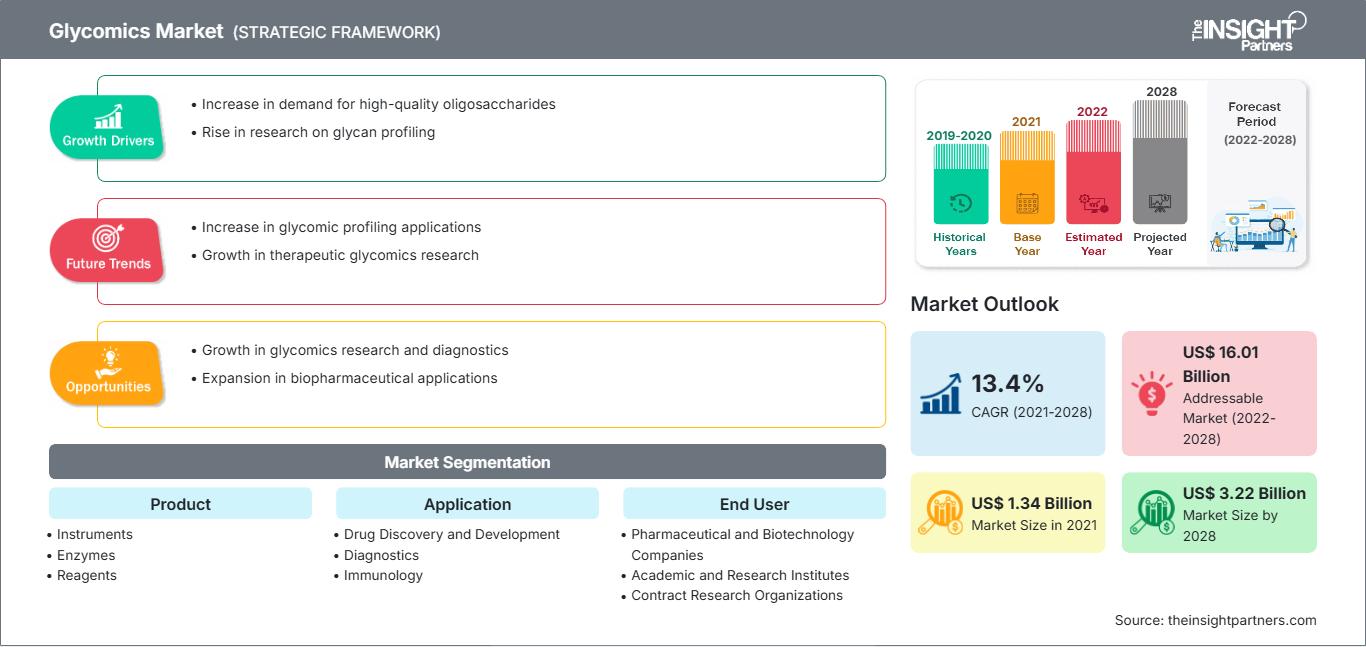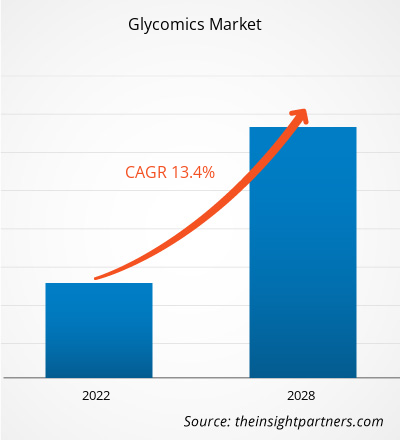[Rapporto di ricerca]Si prevede che il mercato della glicomica crescerà da 1.340,80 milioni di dollari nel 2021 a 3.223,30 milioni di dollari entro il 2028; si stima una crescita a un CAGR del 13,4% dal 2022 al 2028.
I glicani sono responsabili di gran parte della variazione strutturale nei sistemi biologici e la loro rappresentazione sulle superfici cellulari è comunemente chiamata "glicoma". La glicomica è un campo emergente che mira a concentrarsi sulla struttura e la funzione dei glicani in una cellula, un tessuto o un organismo. I glicani sono strutture a catena di carboidrati, liberi o coniugati a macromolecole come lipidi o proteine. Contribuiscono a una vasta gamma di processi biologici come il ripiegamento delle proteine, la segnalazione cellulare e il riconoscimento immunitario. Questi sono implicati in diverse patologie, come quelle oncologiche, autoimmuni e altre. Il mercato della glicomica è trainato dall'incremento della ricerca sulla glicomica, dall'aumento degli investimenti in ricerca e sviluppo e dall'uso della glicomica per il trattamento di varie patologie, che ha portato allo sviluppo di nuovi processi di trattamento. Tuttavia, gli elevati costi delle attrezzature e la carenza di professionisti qualificati ostacolano la crescita complessiva del mercato. Il rapporto offre approfondimenti e analisi approfondite del mercato della glicomica, evidenziando diversi parametri come tendenze di mercato, progressi tecnologici, dinamiche di mercato e analisi del panorama competitivo dei principali attori del mercato globale. Include anche l'impatto della pandemia di COVID-19 sul mercato in tutte le regioni. A causa della pandemia di COVID-19, molte autorità sanitarie si sono concentrate sull'assistenza correlata alla pandemia. Recentemente, ulteriori studi sul coronavirus hanno scoperto meccanismi di infezione che si basano sul virus che utilizza glicani umani. Ad esempio, i ricercatori di GlycoNet hanno dimostrato che il virus COVID-19 entra nelle cellule legandosi ai glicolipidi. I ricercatori stanno ora verificando se le varianti di COVID-19 interessate stiano modificando le loro proprietà di legame ai glicani. Pertanto, la pandemia di COVID-19 ha avuto un impatto positivo sul mercato della glicomica grazie all'incremento della ricerca in tutto il mondo.
Personalizza questo rapporto in base alle tue esigenze
Potrai personalizzare gratuitamente qualsiasi rapporto, comprese parti di questo rapporto, o analisi a livello di paese, pacchetto dati Excel, oltre a usufruire di grandi offerte e sconti per start-up e università
Mercato dei glicomici: Approfondimenti strategici

-
Ottieni le principali tendenze chiave del mercato di questo rapporto.Questo campione GRATUITO includerà l'analisi dei dati, che vanno dalle tendenze di mercato alle stime e alle previsioni.
Approfondimenti basati sulla geografia
Per area geografica, il mercato della glicomica è segmentato in Nord America (Stati Uniti, Canada e Messico), Europa (Francia, Germania, Regno Unito, Spagna, Italia e resto d'Europa), Asia Pacifico (Cina, India, Giappone, Australia, Corea del Sud e resto dell'APAC), Medio Oriente e Africa (Arabia Saudita, Emirati Arabi Uniti, Sud Africa e resto dell'area MEA) e Sud e Africa. America Centrale (Brasile, Argentina e resto dell'America meridionale e centrale).
Approfondimenti di mercato
Crescente utilizzo di glicomici in varie patologie che porta allo sviluppo di nuovi processi di trattamento
Concentrando i propri sforzi nel campo della glicomica, gli scienziati hanno iniziato ad apprendere dettagli importanti sulle funzioni dei glicani e della glicosilazione nell'organismo, inclusa la comunicazione cellulare e ciò che questi fattori potrebbero rivelare sullo sviluppo e la diagnosi delle malattie. La categoria di applicazione più ampia e in più rapida crescita è la scoperta e lo sviluppo di farmaci, principalmente grazie all'aumento della ricerca e sviluppo da parte di aziende farmaceutiche e biotecnologiche e all'espansione delle attività di ricerca sulla scoperta di farmaci negli istituti di ricerca universitari. Ad esempio, nell'aprile 2020, per commercializzare uno strumento all'avanguardia per la rilevazione del cancro, i ricercatori dell'Institute for Glycomics e dell'Università di Adelaide hanno firmato un accordo di licenza esclusiva con Sienna Cancer Diagnostics Ltd. Questi ricercatori hanno creato una proteina speciale chiamata SubB2M, che si lega esclusivamente a una molecola di zucchero, presente solo nelle cellule tumorali. Questa proteina potrebbe rivoluzionare la rilevazione del cancro. Inoltre, nel gennaio 2022, il National Health and Medical Research Council (NHMRC) ha erogato ai ricercatori dell'Institute of Glycomics sovvenzioni per un totale di oltre 1.100.000 milioni di dollari per aiutarli a creare nuovi farmaci per il trattamento delle infezioni da gonorrea multifarmaco-resistenti.
Approfondimenti basati sul prodotto
In base al prodotto, il mercato globale della glicomica è segmentato in enzimi, strumenti, kit e reagenti. Nel 2021, il segmento degli enzimi rappresenterebbe la quota maggiore del mercato; Si prevede inoltre che registrerà il CAGR più elevato nel mercato della glicomica dal 2022 al 2028.
Approfondimenti basati sulle applicazioni
In base all'applicazione, il mercato globale della glicomica è segmentato in scoperta e sviluppo di farmaci, diagnostica, immunologia, oncologia e altri. Il segmento della scoperta e sviluppo di farmaci deterrà la quota maggiore del mercato nel 2021. Tuttavia, si prevede che il segmento della diagnostica crescerà al CAGR più elevato durante il periodo di previsione. I principali fattori trainanti per il segmento delle applicazioni sono l'aumento della ricerca sulle malattie orfane e rare, la crescente necessità di sviluppo di farmaci e la crescente consapevolezza sulla diagnosi precoce.
Approfondimenti regionali sul mercato glicomico
Le tendenze regionali e i fattori che influenzano il mercato dei glicomici durante il periodo di previsione sono stati ampiamente spiegati dagli analisti di The Insight Partners. Questa sezione illustra anche i segmenti e la geografia del mercato dei glicomici in Nord America, Europa, Asia-Pacifico, Medio Oriente e Africa, America Meridionale e Centrale.
Ambito del rapporto di mercato di Glycomics
| Attributo del rapporto | Dettagli |
|---|---|
| Dimensioni del mercato in 2021 | US$ 1.34 Billion |
| Dimensioni del mercato per 2028 | US$ 3.22 Billion |
| CAGR globale (2021 - 2028) | 13.4% |
| Dati storici | 2019-2020 |
| Periodo di previsione | 2022-2028 |
| Segmenti coperti |
By Prodotto
|
| Regioni e paesi coperti |
Nord America
|
| Leader di mercato e profili aziendali chiave |
|
Densità degli attori del mercato della glicomica: comprendere il suo impatto sulle dinamiche aziendali
Il mercato dei glicomici è in rapida crescita, trainato dalla crescente domanda degli utenti finali dovuta a fattori quali l'evoluzione delle preferenze dei consumatori, i progressi tecnologici e una maggiore consapevolezza dei benefici del prodotto. Con l'aumento della domanda, le aziende stanno ampliando la propria offerta, innovando per soddisfare le esigenze dei consumatori e sfruttando le tendenze emergenti, alimentando ulteriormente la crescita del mercato.

- Ottieni il Mercato dei glicomici Panoramica dei principali attori chiave
Approfondimenti basati sull'utente finale
In base all'utente finale, il mercato globale della glicomica è segmentato in aziende farmaceutiche e biotecnologiche, istituti accademici e di ricerca e organizzazioni di ricerca a contratto. Il segmento delle aziende farmaceutiche e biotecnologiche deterrà la quota di mercato maggiore nel 2021 e si prevede che lo stesso segmento crescerà al CAGR più elevato durante il periodo di previsione. Gli operatori del mercato della glicomica adottano strategie organiche come il lancio e l'espansione di prodotti per espandere la propria presenza e il portafoglio prodotti a livello mondiale e soddisfare la crescente domanda. Alcuni dei principali attori che contribuiscono al mercato della glicomica sono Merck KGaA; Agilent Technologies, Inc.; New England Biolabs; Thermo Fisher Scientific Inc.; Waters Corporation; Asparia Glycomics; Bruker Corporation; Takara Bio Inc.; S-BIO; e Shimadzu Corporation, tra gli altri.
- Analisi storica (2 anni), anno base, previsione (7 anni) con CAGR
- Analisi PEST e SWOT
- Valore/volume delle dimensioni del mercato - Globale, Regionale, Nazionale
- Industria e panorama competitivo
- Set di dati Excel
Report recenti
Testimonianze
Motivo dell'acquisto
- Processo decisionale informato
- Comprensione delle dinamiche di mercato
- Analisi competitiva
- Analisi dei clienti
- Previsioni di mercato
- Mitigazione del rischio
- Pianificazione strategica
- Giustificazione degli investimenti
- Identificazione dei mercati emergenti
- Miglioramento delle strategie di marketing
- Aumento dell'efficienza operativa
- Allineamento alle tendenze normative






















 Ottieni un campione gratuito per - Mercato dei glicomici
Ottieni un campione gratuito per - Mercato dei glicomici